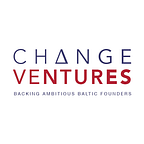Why Change Ventures backed Aerones, the robotics startup re-inventing wind turbine blade inspection and maintenance
In late 2018 the founders of Aerones got a cold email from YCombinator, who had seen the video of their super-cool industrial heavy lift drone and invited them to California to pitch YC. After a trip to California they secured a ticket to the world's most famous accelerator program. The idea to build such a drone was a crazy idea from the CEO Janis Putrams — they really did not have a clear idea what to do with it at the time but, being hustling technology entrepreneurs, figured that they would find many applications. To build the drone, Janis had teamed up with his former co-founder, Dainis Kruze and a world-class electric motor specialist, Andris Dambis, who had built the electric race car that won the Pike's Peak Race multiple times.
During the YC program they talked to many potential customers and it became clear that the wind energy industry — large, growing and very important to the future of renewables — has a massive problem. Wind turbine blades are getting bigger and bigger as the industry scales the technology and are multiplying rapidly in quantity deployed. As the early turbines enter 5, 10 or more years of operation, it is now clear that if the turbine blades are not maintained properly, energy efficiency begins to drop and the ROI of wind energy suffers. But maintenance (cleaning, inspecting for cracks, checking that lightning conductivity is working etc.) is hard manual work, with rope access technicians hanging from the top of turbines (the “nacelle”) and manually performing these tasks. Obviously this work is limited by safety regulations, the inability to work in higher winds or at night and the complexities of scheduling many thousands of technicians. Aerones believed that their drone could solve the problem much better and began pilot tests.
I met Dainis Kruze, the co-founder, right after they graduated YC. I was excited by the potential, but as yet unconvinced that they had really figured out what their technology was useful for, so we initially declined the investment. Like with most of the entrepreneurs we meet, we stayed in touch and helped out where we could, even though we did not invest at the time.
What I like about teams like Aerones is that they generally take “no” as a red flag that just makes them more determined to prove that they can do what they set out to do. Over the coming two years they delved deep into the wind energy industry, talking to hundreds of customers, testing their solution in the field, constantly trying to figure out how to optimize it. At some point during the process, Janis had a realization that a drone was not the most elegant solution to this problem. He came up with a ground-based winch system, with three winches anchoring a robot that was held up by a rope & pulley thrown out of the nacelle. No rope-climbing needed and the robotic arm that this winch system held could be easily maneouvered, precisely up and around both sides of the turbine blade. With different tools on the robotic arm, they could perform an even much larger range of services. This patent-pending technology underpins their current product.
Fast forward to 2020 and Aerones has field tested their solution and now has robots deployed in the USA and Europe working every day servicing commercial customer's turbine blades. The range of services available has expanded from the original concept of cleaning dirt, dust, bugs and other materials from the turbine blade surface to a range of other services. Detailed photographic inspection is using high-resolution close-up photography that is more detailed than using a drone, which cannot get that close to the blade. In addition to visual inspection, a laser surface scanning arm can generate an extremely detailed model of the surface of the blade for analysis. Lightning conductivity tests can be performed that measure the whole loop from receptor on the blade to the bracket at the base of the turbine (lightning is one of the key sources of danger for wind turbines, that are typically the highest structures wherever they are installed). The robot can maneouver so precisely as to also clean out small drainage holes in the blade and blade tip with a special brush. Applying coatings to the blade surface is possible, including ice-phobic coatings for regions where ice formation on the blade is a challenge, as well as painting the surface of the blade. The team is also field testing a system for full leading edge repair including stripping down sections of the blade surface, sanding them, buffing them and applying filler, then heat-treating it to set it. All of these services use the same delivery system, just with different attachments to the robotic arm. The result is that inspection, maintenance and repair of the blade can take much less time than before, getting the turbine back into operation faster, with improved efficiency.
Change Ventures is excited to join YCombinator and a great list of angel investors, including our venture partner Janis Krums and the creator of Gmail, Paul Bucheit, as backers of these ambitious Baltic founders. With $1.6M in seed funding, 2.7M Euros of grant funding from Inno Energy and separate funding for the services subsidiary Aerones Nordic, the company is in a great position to scale commercial deployments of the solution over the coming years.
